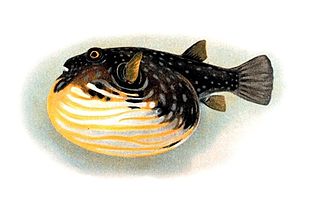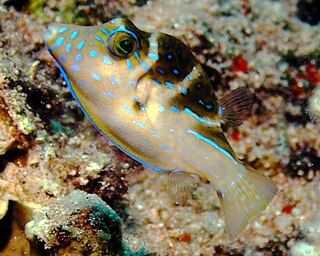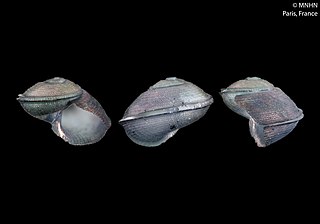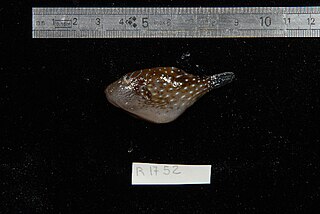
Tetraodontidae is a family of primarily marine and estuarine fish of the order Tetraodontiformes. The family includes many familiar species variously called pufferfish, puffers, balloonfish, blowfish, blowies, bubblefish, globefish, swellfish, toadfish, toadies, honey toads, sugar toads, and sea squab. They are morphologically similar to the closely related porcupinefish, which have large external spines. The scientific name refers to the four large teeth, fused into an upper and lower plate, which are used for crushing the hard shells of crustaceans and mollusks, their natural prey.

Canthigaster is a genus in the pufferfish family (Tetraodontidae). A fish from this genus is sometimes referred to as a "toby" or a "sharpnose puffer".
This article is a list of biological species, subspecies, and evolutionary significant units that are known to have become extinct during the Holocene, the current geologic epoch, ordered by their known or approximate date of disappearance from oldest to most recent.
Sophora rapaensis is a species of flowering plant in the pea family, Fabaceae, that is endemic to French Polynesia.

The Philippine tube-nosed fruit bat locally known in Tagalog as Bayakan is a species of bat in the family Pteropodidae. It is endemic to the Philippines and known from the islands of Cebu, Negros and Sibuyan. It occurs in and near primary and secondary subtropical or tropical dry forests. It is often found near water. It is threatened by habitat loss due to deforestation. The species is named for Dioscoro S. Rabor who, with several others, first collected the species.
Bat Conservation International (BCI) is an international nongovernmental organization working to conserve bats and their habitats through conservation, education, and research efforts.

Canthigaster coronata, commonly called the crowned toby, is a species of pufferfish endemic to the Hawaiian Islands. It occasionally makes its way into the aquarium trade.

Canthigaster bennetti is a pufferfish from the Indo-Pacific. It occasionally makes its way into the aquarium trade. It grows to a size of 10 cm in length.

Anatoma rapaensis is a species of sea snail, a marine gastropod mollusc in the family Anatomidae.

Canthigaster margaritata, the pearl toby, is a species of "toby" or "sharpnose puffer" (Canthigaster), which is part of the pufferfish family, Tetraodontidae. This reef fish is found in Indo-Pacific waters, including the Red Sea.
Canthigaster cyanetron is a species of pufferfish of the family Tetraodontidae. The species is endemic to Easter Island, and is an Endangered species due to coral reef bleaching of its habitat.

Canthigaster amboinensis, commonly known as Ambon pufferfish or Ambon toby, is a species of pufferfish of the family Tetraodontidae. The species is endemic to Australia, Indonesia, Japan, Papua New Guinea, Taiwan and the Hawaiian Islands.
Cyrtodactylus thuongae is a species of gecko, a lizard in the family Gekkonidae. The species is endemic to Vietnam.

Nanhaipotamon is a genus of freshwater crabs, in the subfamily Potamiscinae, found in southern China and Taiwan. As of 2018, 18 species have been described. The genus is named after the South China Sea, for it occurs mostly in coastal areas.

Canthigaster rivulata commonly known as the brown-lined puffer, or kitamakura is a marine fish belonging to the family Tetradontidae.

Lupulella is a genus of canine found in Africa. This genus consists of only two extant species, the black-backed jackal and the side-striped jackal.

Canthigaster cyanospilota, commonly known as blue-spotted toby, is a species of pufferfish of the family Tetraodontidae. The species is found throughout the Indian Ocean, including the red Sea and Gulf of Aqaba. They feed on a variety of benthic invertebrates and are listed in the IUCN Red List as Least Concern.












